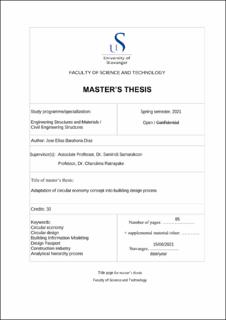| dc.description.abstract | Circular economy (CE) is an economic system that is restorative and regenerative by design and aims to keep products, components, and materials at their highest utility and value always, distinguishing between technical and biological cycles. By using circular economy, the value of products and materials is maintained in the economy for as long as possible, thus minimizing the production of waste and reducing/avoiding the extraction of new resources. The main objectives of circular economy in the construction industry are to avoid waste at the design stage, minimize waste generation during construction, preserve the quality and value of materials during operation, and to ensure reusing or recycling of building components and material at the end of the lifespan.
This research investigated the adoption of circular economy in the building design process by identifying and describing the concept, indicators, characteristics, and strategies of circular economy in the construction industry. This study also analyzed the implementation of circular economy in the construction industry by developing a BIM case study to show the adoption of circular economy in the building design process. The case study is a junior high school building in Bogafjell, Norway. The school has a capacity of 504 students, a net area of 9.35m² per student. The building is a four-floor structure made of concrete and steel, additionally the school has a pedestrian bridge made of steel and retaining walls on the sides made of reinforced concrete. The BIM model of the case study was provided by the Norwegian consulting company Multiconsult.
This study created a framework of adapting CE in the building design process. A material passport (MP) analyzes the recyclability of the materials in a building once the building is designed and completed. This study proposes a new material passport from the design phase point of view, which will be called Design Passport (DP). The Design Passport will help the structural engineers decide what materials and structural components are better to design a circular building by adopting CE indicators. In the early stage of the circular economy framework, a feasibility study must be included to help construction companies have a better selection of their materials and better product development process for the adoption of circular economy. The analytical hierarchy process assists the construction companies in the decision process of evaluating and determining if a structural element of the project can be reused or recycled. This study selected a precast reinforced concrete wall from the case study to apply the model. A re-evaluation analysis of the structural components is necessary at the end of a project’s life cycle to determine if the components are still in optimal conditions for further reuse in another projects.
The projects in the construction industry vary vastly in sizes, location, materials, and construction methods. This study used a junior high school building as a case study, but the design passport and feasibility study can be utilized in other different projects. This highlights the importance of carrying out case studies to have a better understanding how to adopt circular economy in different kinds of projects. Circular buildings are a relatively new concept construction companies want to implement. Few case studies have been done in the adoption of circular economy in the construction industry. | |
